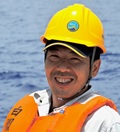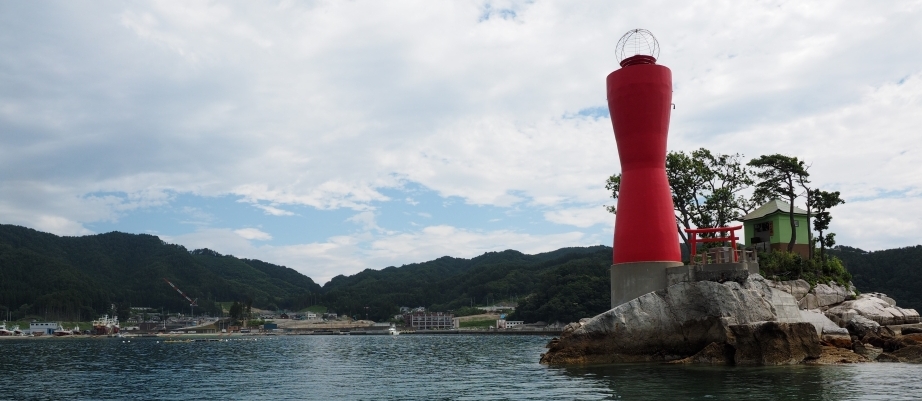Hoisting the Flag for “Intellectual Curiosity”
Coastal Marine Science @ Iwate Prefecture

Contributed by Jun Aoyama (from Kanagawa)
Professor
International Coastal Research Center, Atmosphere and Ocean Research Institute
An oceanographer who has traveled the world to elucidate the mysterious ecology of eels is embarking on a new voyage with a focus on the sea of Sanriku. Hoisted at the bow of his metaphorical ship is a flag. On this flag is inscribed an idea that had once faded following the March 11 disaster: “intellectual curiosity.”

Yoshinori Ohsumi, Honorary Professor at the Tokyo Institute of Technology and winner of the Nobel Prize in Physiology or Medicine, pointed out the importance of basic research that does not necessarily contribute to society. His words are still fresh in our minds. Looking back, I have been conducting a range of research activities in rivers and oceans across the world in order to find an answer to the question “Why do eels travel?” starting with the elucidation of their evolutionary development. Just as my teacher Emeritus Professor Katsumi Tsukamoto of the University of Tokyo likes to say, the story of the eel is a romantic one; they spawn in the Mariana seamounts at night under a new moon. I have been lucky enough to collect eel eggs as well as the eels that laid them, to discover a new species of eel, and be present for various historic firsts, simply as a result of my feverish drive to satisfy my own intellectual curiosity. In fact, I would say I have been devoted to my research for this very reason, ignoring those who questioned how this was of benefit to society.
I began working at the International Coastal Research Center (ICRC) of the Atmosphere and Ocean Research Institute in April 2014. The ICRC is located in Ōtsuchi Town in Iwate Prefecture, and suffered tremendous damage in the Great East Japan Earthquake. The first and second floors of the building were totally destroyed by the tsunami, but the ICRC remained operational by refurbishing the third floor, which had also flooded. With the help of the local community, a survey vessel was promptly built in order for the ICRC to investigate the damage done to coastal ecosystems as a result of the earthquake and tsunami. The investigation and research activities were undoubtedly important for the recovery of the local fisheries industry, and also in terms of meeting the strong social need for making preparations for similar disasters. Setting foot into town, you can still see vivid traces of the lives, property and memories viciously taken away by the disaster. As the locals, the town, and the whole community were breaking free of the tragic memories of the disaster and pressing forward towards recovery, the concept of “intellectual curiosity” seemed to be completely irrelevant. Now, three years have passed since I arrived here, and the local atmosphere is slowly changing. As part of the natural course of recovery efforts, a tsunami-resistant town has been built. And now, the fact that people bring towns to life, which is often taken for granted, is becoming strikingly apparent. While the central area has finally recovered, Ōtsuchi Town is finding it difficult to convince residents to stay, so the number of houses rebuilt is far lower than expected. From this point forth, the town will face the same challenge as similar places throughout the country: how to tackle the decline of regional areas symptomatic of depopulation and the aging of society.
I began working at the International Coastal Research Center (ICRC) of the Atmosphere and Ocean Research Institute in April 2014. The ICRC is located in Ōtsuchi Town in Iwate Prefecture, and suffered tremendous damage in the Great East Japan Earthquake. The first and second floors of the building were totally destroyed by the tsunami, but the ICRC remained operational by refurbishing the third floor, which had also flooded. With the help of the local community, a survey vessel was promptly built in order for the ICRC to investigate the damage done to coastal ecosystems as a result of the earthquake and tsunami. The investigation and research activities were undoubtedly important for the recovery of the local fisheries industry, and also in terms of meeting the strong social need for making preparations for similar disasters. Setting foot into town, you can still see vivid traces of the lives, property and memories viciously taken away by the disaster. As the locals, the town, and the whole community were breaking free of the tragic memories of the disaster and pressing forward towards recovery, the concept of “intellectual curiosity” seemed to be completely irrelevant. Now, three years have passed since I arrived here, and the local atmosphere is slowly changing. As part of the natural course of recovery efforts, a tsunami-resistant town has been built. And now, the fact that people bring towns to life, which is often taken for granted, is becoming strikingly apparent. While the central area has finally recovered, Ōtsuchi Town is finding it difficult to convince residents to stay, so the number of houses rebuilt is far lower than expected. From this point forth, the town will face the same challenge as similar places throughout the country: how to tackle the decline of regional areas symptomatic of depopulation and the aging of society.

The Sanriku coastal region has been shaped through its relationship with the ocean, which has not only provided people with infinite wisdom but has also brought about disasters that surpass the boundaries of human knowledge. The region can never separate itself from the ocean, despite it being the source of the tremendous disaster; rather, it is urgently imperative for the region to once again find hope in the ocean. The University of Tokyo’s Institute of Social Science (ISS) has been working on the “Social Sciences of Hope” project in Kamaishi City, Iwate Prefecture. When asked “What is hope?” the ISS answered, “A wish for something to come true by action.” “Hope” does not consist of mere desires for food or material goods, so the “something” here goes beyond its conventional meaning—something noble, something spiritual. I interpret “hope” as a passionate desire to protect one’s own identity. So, if people can rebuild their identity by taking pride in the ocean that extends before them through the effort of marine science research, a new sense of hope could emerge in the region. Seriously engaging in idealistic or adventurous research activities driven by pure intellectual curiosity may therefore make a tremendous contribution to local communities. At our research institute located in the disaster-stricken Sanriku region, we are striving to contribute to the local area through “useless” basic research, hoisting high our flag for intellectual curiosity with support from the ISS. We call this initiative “A School for Marine Sciences and Local Hopes in the Sanriku Coastal Area.” This virtual school will open soon.
Note: This article was originally printed in Tansei 35 (Japanese language only). All information in this article is as of September 2017.
Note: This article was originally printed in Tansei 35 (Japanese language only). All information in this article is as of September 2017.






